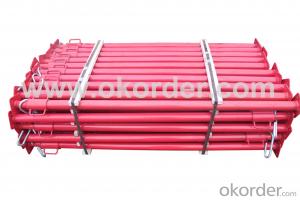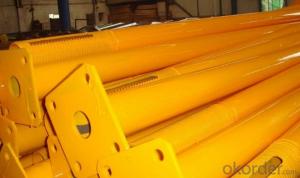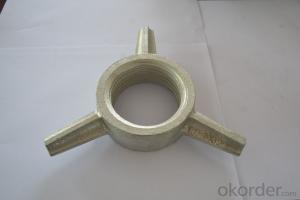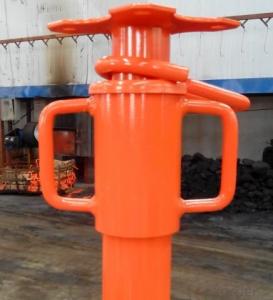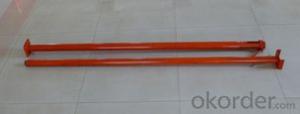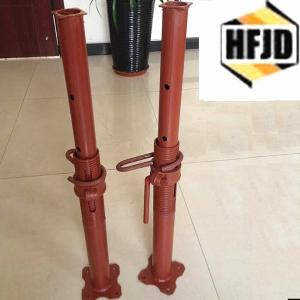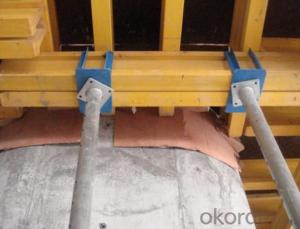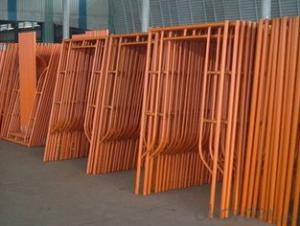Construction formwork support Steel Prop
- Loading Port:
- Tianjin
- Payment Terms:
- TT OR LC
- Min Order Qty:
- 10000 PCS
- Supply Capability:
- 10000 PCS/month
OKorder Service Pledge
OKorder Financial Service
You Might Also Like
Quick Details
| Model Number: | QSFW3040-3057 | ||
| Type: | Formwork | Surface finish: | painted, galvanized, hot dipped galvanized |
Packaging & Delivery
| Packaging Detail: | Bundle or according to your requirement |
| Delivery Detail: | 20-40 days |
Specifications
1) Surface finish: painted, galvanized, hot dipped galvanized
2) Steel grade Q235,following UNI EN 10219-1/2;
1) Colour: red color painted,orange or other color( upon your request )
2) Hot dipped galvanized:thickness guaranteed Min.50µm following UNI EN 40.
3) Type: Acrow Prop ; Portuguese type prop ; U-head prop ; Italian type prop (popular) ; Prop with casting sleeve ; Prop all galv. ; Prop with casting sleeve ; Spanish type prop ; Prop with reinforced base ; Heavy duty prop ; French type prop
4) We have been supplying to the following countries with props:
ITALY,SPAIN,FRANCE,GERMANY,PORTUGAL,BELGIUM,HOLLAND,U.K. IRELAND,DENMARK,AUSTRALIA,NEW ZEALAND,U.S.A. BRAZIL,ARGENTINA,ect.
5) All our props are made as per Euorpean standard and Australian standard and American standard.All our customers are very happy with our quality of props.
| Popular Prop | Spec. | Weight |
Italian Type Props Steel prop External Diameter :Φ56x1.6mm, Internal Diameter:Φ48x1.8mm | 220/400CM | 11.20kgs |
| 200/360CM | 10.00kgs | |
| 160/290CM | 8.50kgs |
- Q:Are steel props suitable for supporting temporary stairs or ramps?
- Yes, steel props are suitable for supporting temporary stairs or ramps. Steel props are known for their high load-bearing capacity and stability, making them ideal for providing structural support to temporary structures like stairs and ramps.
- Q:Are steel props adjustable in tight spaces?
- Yes, steel props are adjustable in tight spaces. Steel props, also known as adjustable steel props or steel shores, are commonly used in construction to support temporary structures such as formwork, scaffolding, or beams. These props consist of a steel tube with a threaded external portion and an internal tube that slides within the outer tube. This design allows for easy adjustment to different heights and ensures stability and load-bearing capacity. In tight spaces where there may be limited room for movement, the adjustable nature of steel props allows for precise positioning and support, making them suitable for various construction scenarios.
- Q:Can steel props be used as temporary support during excavation work?
- Yes, steel props can be used as temporary support during excavation work. Steel props, also known as adjustable steel props or acrow props, are commonly used in construction and excavation projects to provide temporary support to structures and prevent collapse. They are lightweight yet sturdy, making them ideal for supporting walls, beams, and other structures during excavation work. Steel props are adjustable in height, allowing them to be easily extended or retracted to fit the required support length. They are designed to withstand heavy loads and provide stability and safety to the excavation site. Additionally, steel props are versatile and can be used in a variety of soil conditions and excavation depths. However, it is important to ensure that the steel props are properly installed, maintained, and regularly inspected to ensure their effectiveness and safety during excavation work.
- Q:Are steel props suitable for supporting temporary flooring or decking?
- Yes, steel props are suitable for supporting temporary flooring or decking. Steel props are durable, strong, and adjustable, making them an ideal choice for providing stable support for temporary structures like flooring or decking. They can withstand heavy loads and are easy to install and remove, making them a practical solution for temporary construction projects.
- Q:What are the maintenance requirements for steel props?
- The maintenance needs of steel props can differ based on the specific conditions they encounter and the type of steel utilized. Nevertheless, there are some general guidelines that can aid in guaranteeing the durability and optimal functioning of steel props. 1. Regular cleansing: To eliminate accumulated dirt, dust, and other debris on the surface, it is important to regularly clean steel props. This can be accomplished by using a mild soap and water solution, followed by thorough drying to prevent corrosion. 2. Inspection: Regular inspections are vital for detecting any indications of damage, wear, or corrosion. Examine the props for cracks, bent sections, loose components, or any other irregularities that could compromise their structural integrity. If any issues are identified, they should be promptly addressed. 3. Lubrication: Proper lubrication of the moving parts of steel props is essential to reduce friction and prevent rust. This can be achieved by applying an appropriate lubricant, such as oil or grease, to the relevant areas. However, it is crucial to utilize the lubricant recommended by the manufacturer to avoid adverse effects. 4. Storage: Adequate storage is crucial for safeguarding steel props against environmental elements that may cause damage. When not in use, props should be stored in a dry and well-ventilated area to prevent moisture accumulation and corrosion. Additionally, they should be stored in a manner that minimizes the risk of accidental damage or deformation. 5. Avoiding excessive loads and misuse: Steel props have specific load-bearing capacities that should not be exceeded. It is crucial to utilize them within their designated limits to prevent structural failure or accidents. Moreover, they should not be employed for purposes they were not designed for, as this can result in premature wear and damage. 6. Regular maintenance by professionals: Depending on usage frequency and specific requirements, it may be necessary to have professionals periodically inspect and service the steel props. This can ensure that any potential issues are promptly addressed and that the props are in optimal condition for safe and efficient use. By adhering to these maintenance requirements, steel props can enjoy an extended lifespan and continue to provide dependable support for various construction and structural applications.
- Q:What is the maximum deflection allowed for a steel prop?
- The maximum deflection allowed for a steel prop typically depends on various factors such as the specific application, load capacity, and safety standards. It is recommended to refer to the manufacturer's guidelines or relevant engineering codes to determine the specific maximum deflection allowed for a steel prop in a particular context.
- Q:Can steel props be used for supporting temporary aerial platforms or lifts?
- Yes, steel props can be used for supporting temporary aerial platforms or lifts. Steel props, also known as adjustable steel props or scaffolding props, are commonly used in construction projects to provide temporary support for structures or platforms. They are specifically designed to be adjustable in height, making them suitable for various applications, including supporting aerial platforms or lifts. Steel props are known for their strength and stability, which makes them a reliable choice for providing a secure and sturdy base for temporary platforms or lifts. Additionally, they can be easily adjusted to different heights, allowing for flexibility in setting up the desired elevation for the platforms or lifts. However, it is important to ensure that the steel props are properly installed and meet the required safety standards to ensure the safety of workers and the stability of the supported structure.
- Q:How do you calculate the required load capacity for a steel prop?
- Calculating the necessary load capacity for a steel prop involves taking several factors into consideration. First and foremost, one must ascertain the maximum load that the prop will bear. This can be determined by analyzing the weight of the object or structure that the prop is intended to support. Subsequently, it is advisable to consult the steel prop's specifications to identify its load capacity or safe working load limit (SWL). This crucial information is typically provided by the manufacturer and can be found in the prop's documentation or labeling. Ensuring that the prop's load capacity is equal to or greater than the maximum load applied is of utmost importance. If the load capacity falls short of the maximum load, it could result in the prop's failure, thereby creating serious safety hazards. Furthermore, it is essential to consider any additional factors that might influence the prop's load capacity. These factors can include the prop's height, the angle at which it is positioned, and any lateral forces that may be present. It is worth noting that the load capacity of a steel prop is generally specified for vertical loads. If the prop is subjected to horizontal or inclined loads, further calculations or adjustments may be necessary to ensure its stability and safety. To summarize, calculating the necessary load capacity for a steel prop entails determining the maximum load, examining the manufacturer's specifications, and taking into account any other factors that may impact the prop's stability.
- Q:Do steel props require any special tools for installation?
- Special tools are typically necessary for installing steel props. These tools may consist of a wrench or spanner for tightening the adjustable screws on the prop, a hammer or mallet to firmly anchor the base plate into the ground, and occasionally a crowbar or lever for adjusting the prop's height as desired. Moreover, a spirit level might be required to guarantee that the prop is perfectly vertical. These tools play a critical role in securely installing steel props and ensuring their ability to support their intended load safely and effectively.
- Q:How do you prevent steel props from sinking in clay soil?
- To prevent steel props from sinking in clay soil, there are several actions that can be taken: 1. Opt for larger and wider steel props: By increasing the surface area of the steel props, the weight can be distributed more evenly, reducing the risk of sinking. Consider utilizing props with tubes of larger diameter or base plates that are wider. 2. Increase the quantity of props: By adding more steel props, the load can be spread across a larger area, minimizing the pressure on each individual prop and decreasing the likelihood of sinking. 3. Install steel props at a greater depth: By digging a hole for the steel props that is deeper, a more stable foundation can be achieved. This will extend below the clay layer and reach into more stable soil or rock, providing a stronger support system to prevent sinking. 4. Employ concrete footings: By pouring concrete footings or foundations beneath the steel props, additional stability can be attained. The concrete footings will help distribute the load more evenly, preventing sinking in clay soil. 5. Incorporate a layer of gravel or crushed stone: Placing a layer of gravel or crushed stone beneath the steel props can enhance drainage and decrease the chances of sinking. This layer will serve as a stable base, preventing the clay soil from becoming overly saturated with water. 6. Implement ground improvement techniques: In situations where the clay soil is particularly unstable, ground improvement techniques can be utilized. These techniques include methods such as soil stabilization, compaction, or the use of geosynthetic materials to enhance the load-bearing capacity of the soil. It is important to consider that these measures should be evaluated based on site-specific conditions and engineering recommendations. Seeking advice from a geotechnical engineer or structural engineer can provide valuable insights and guidance to ensure the stability and safety of steel props in clay soil.
1. Manufacturer Overview |
|
|---|---|
| Location | |
| Year Established | |
| Annual Output Value | |
| Main Markets | |
| Company Certifications | |
2. Manufacturer Certificates |
|
|---|---|
| a) Certification Name | |
| Range | |
| Reference | |
| Validity Period | |
3. Manufacturer Capability |
|
|---|---|
| a)Trade Capacity | |
| Nearest Port | |
| Export Percentage | |
| No.of Employees in Trade Department | |
| Language Spoken: | |
| b)Factory Information | |
| Factory Size: | |
| No. of Production Lines | |
| Contract Manufacturing | |
| Product Price Range | |
Send your message to us
Construction formwork support Steel Prop
- Loading Port:
- Tianjin
- Payment Terms:
- TT OR LC
- Min Order Qty:
- 10000 PCS
- Supply Capability:
- 10000 PCS/month
OKorder Service Pledge
OKorder Financial Service
Similar products
New products
Hot products
Related keywords



